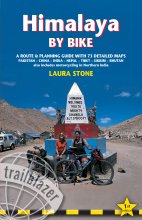These Trailblazer guides … are a godsend for independent travelers.
— Travel & Leisure

Himalaya by Bike
Excerpt:
Costs and Money
Contents | Introduction | Route options | When to go | Costs and Money | Sample route guide - Siliguri to Mirik

The true cost of a Himalayan cycling adventure obviously adds up to a lot more than the flight and daily expenses on the road. The plus side is that hopefully you've already spent money on the following:
- a serviced bike in good shape
- clothing
- panniers and racks
- camping gear including tent, stove and sleeping bag
- guidebooks and maps
- cycle computer and maybe a GPS
- immunizations
- travel insurance
- visas
- travel arrangements
The cost of the trip also depends on how you like to travel.
India and Pakistan are the cheapest countries to travel in where a few hardy individuals can ride around India and Pakistan on US$5 a day but this means sleeping rough or with a family and eating the staple diet of dahl baaht (lentils and rice).
Most budget travellers expect to spend around US$10 a day which in India will buy a cheap room for the night and simple but varied meals and snacks.
Nepal has tourist resorts at European prices – tempting after a rough fortnight in Tibet – and in Tibet prices are high anyway.
By regional standards Bhutan is off the scale: an all-inclusive package here costs US$200 a day.
Budget-breakers include sightseeing, tours, expensive bike repairs and emergency jeeps or flights if you get ill.
Some days camping in the middle of nowhere you'll spend nothing; other days, especially when you've reached your destination, deserve a real splurge on a good hotel and great food.
All of these countries operate a two-tiered system for tourist attractions: one price for nationals and another, much higher price for foreigners: Rs20 jumps up to Rs750 in the case of India's Taj Mahal.
MONEY
For trips over a month it's worth thinking about how you're going to manage what money you have left at home. Internet banking is useful for keeping track and saves someone at home from having to deal with your finances.
As for cash, the US dollar is the best foreign currency to carry in Asia.
If you don't have a credit card consider getting one. Some airlines will only accept credit cards, not debit cards.
A credit card also offers protection against online fraud but note that any banks now slap on a charge if you withdraw cash from a foreign ATM; better to use a debit card for this.
Visa has got the best presence in Asia (see the Visa website for an ATM locator), followed at a distance by MasterCard and then American Express.
Debit cards with any symbol other than Visa (eg any of MasterCard's offshoots such as Maestro, Switch, Solo or Cirrus) are often refused.
Installed in 2007, Bhutan's ATMs do not yet accept foreign cards.
Even if you have no intention of using it, a credit card is invaluable in an emergency.
Debit cards are good for ATMs and more convenient than travellers’ cheques, though without doubt travellers’ cheques are the safest way to carry large amounts of money.
Thomas Cook and American Express travellers’ cheques are accepted throughout Asia although money-changers prefer cheques issued in US dollars to Euros and might well refuse sterling.
When buying travellers’ cheques look for somewhere you can cash in any unused cheques on your return.
Once abroad some money-changers offer a good exchange rate but sting you on commission charges and others do the reverse.
As with everything shop around for the best rates.
Note that the rate for travellers’ cheques is nearly always worse than that for hard cash.
In India keep hold of some ATM and foreign exchange receipts as these 'encashment receipts' may be requested when booking flights and trains.
CARRYING YOUR MONEY
you'll often have to carry enough cash to last at least a fortnight so many cyclists carry a small amount in a zipped pocket or handlebar bag, and stash travellers’ cheques and credit cards in something they always carry with them.
Ortlieb handlebar bags have space under the plastic liner for a Ziploc bag of cash, cards and photocopied documents.
Some people like to use a money belt (the kind that is actually a trouser belt), and keep an emergency $100 hidden somewhere crafty like within the frame of the bike.
In unsafe areas, some travellers also carry a fake wallet containing expired cards and valueless notes which can be handed over quickly in the event of a mugging (highly unlikely in the Himalaya).
Latest tweets